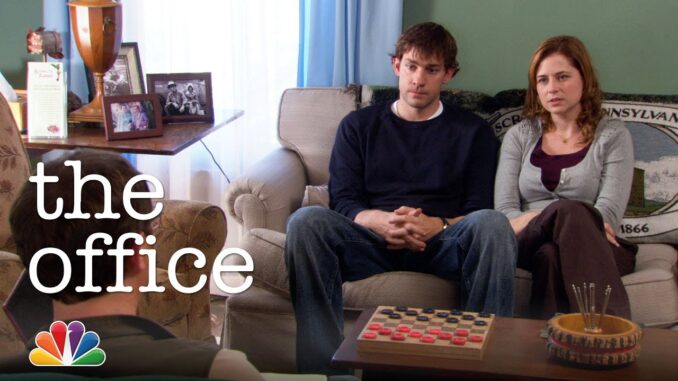
The gravel crunched under the tires of Jim’s car as they turned off the paved road, the sound a prelude to the unpaved reality of Schrute Farm. Pam, already stifling a giggle, glanced at Jim, whose signature ‘are-you-seeing-this?’ eyebrow raise was already in full effect. They had booked a night at Schrute Farms B&B on a whim – a dare, perhaps, or a desperate attempt at a quiet getaway when every other lodge was booked. They knew it would be weird, but they weren't prepared for the layers of eccentricity that would peel away like the skin of an impossibly large onion, revealing increasingly baffling truths.
The air itself was the first secret, a pungent blend of earth, manure, and an undeniable, overwhelming scent of beets. Their "American Gothic" themed room was a study in oppressive authenticity: a lumpy, hand-stitched quilt, a framed, faded photograph of a stern-looking patriarch with eyes suspiciously like Dwight’s, and a taxidermied squirrel posed mid-scream on the mantelpiece. Jim gave the squirrel a long, appraising look. "He looks like he just saw the bill," he whispered to Pam, who bit her lip to keep from laughing aloud. This was their coping mechanism: turn the surreal into a running commentary, a shared game of ‘Schrute Bingo’.
The initial layers of weirdness were superficial, almost charmingly so. Dinner was, predictably, beet-centric, served by a silent Mose in an uncomfortably warm dining room. Dwight, as the self-appointed tour guide and host, expounded on the philosophical underpinnings of manure composting and the superior genetic fortitude of Schrute lineage. Jim and Pam exchanged knowing glances, their silent language of amusement deepening with every bizarre pronouncement.
But the real uncovering began after dark, drawn by the irresistible pull of a flickering light from the barn and the faint, rhythmic thudding that occasionally punctuated the rural quiet. Jim, ever the instigator, nudged Pam. "Curiosity killed the cat, but satisfaction brought it back," he quoted, poorly. Armed with their phone flashlights and a spirit of investigative journalism, they ventured out.
Their first significant discovery was not a secret chamber, but a secret purpose for something seemingly mundane. The "manure pile" Dwight had so proudly showcased earlier was not merely a mound of decomposing waste. Deep within its steaming depths, Jim’s flashlight beam revealed not just earthworms, but intricate, almost ritualistic patterns, carved into the compost, glowing faintly in the moonlight. Pam gasped softly. "Is that… a crop circle?" Jim leaned closer. "Or a very elaborate sacrifice to the beet gods." Dwight, they realized, wasn't just farming; he was conducting esoteric agricultural rituals.
Further exploration led them to the family cemetery, which Dwight had described as merely "a place of eternal repose." It was, in fact, an open-air museum of Schrute history, each gravestone not just bearing a name and date, but an accompanying tableau. One grave, marked "Ignatius Schrute, Died of Bear Attack, 1873," featured a life-sized, crudely carved wooden bear mauling a similarly crude human effigy. Another, belonging to "Hildegard Schrute, Beloved Beekeeper," was surrounded by dozens of empty, rusting beehives, each one bearing a tiny, unidentifiable inscription. It was less a cemetery and more a macabre, perpetual performance art installation.
The most unnerving secret, however, lay beneath the main farmhouse. Driven by the distant sound of what Jim swore was "a poltergeist trying to play the banjo," they found a loose floorboard in the utility room. Beneath it, a narrow, surprisingly deep tunnel led into the cold, damp earth. Their flashlights cut through the gloom, revealing not a root cellar, but a meticulously organized, subterranean bunker. Shelves lined with jars of pickled beets shared space with gas masks, antiquated firearms, and a surprisingly robust library of survivalist guides from the early 20th century.
But the true chilling secret was on the far wall: a series of hand-drawn genealogical charts that traced the Schrute line not just through human ancestors, but through generations of beets, sheep, and, most disturbingly, what appeared to be hybrid beet-sheep creatures. One particularly unsettling diagram depicted a human figure with roots for legs and leaves for hair, labeled "Homo Beta Schrute."
Jim and Pam exchanged a look that transcended amusement. It was a shared moment of profound, slightly terrified understanding. This wasn't just Dwight being Dwight; this was generations of Schrutes cultivating a lineage of eccentricities, preparing for an apocalypse that only they could foresee, and perhaps, even orchestrating. The farm wasn't just a place; it was a living, breathing, beet-scented monument to a deeply ingrained, uniquely Schrute worldview.
They left the next morning, exhausted and strangely invigorated, their shared ordeal solidifying their bond in a new way. As the Schrute Farm sign receded in the rearview mirror, Pam leaned her head on Jim’s shoulder. "I think," she said, her voice a little shaky, "we discovered more than we bargained for." Jim nodded, a slow smile spreading across his face. "Yeah," he mused, "I think we just found the missing link between humans and root vegetables." The secrets of Schrute Farm, they realized, weren't just weird; they were fundamental, etched into the very soil, waiting for unsuspecting visitors to unearth them, one bizarre revelation at a time.
